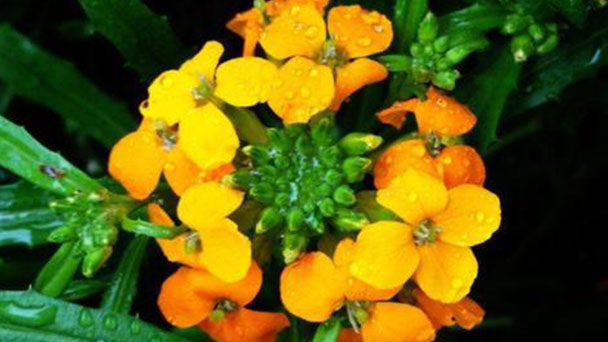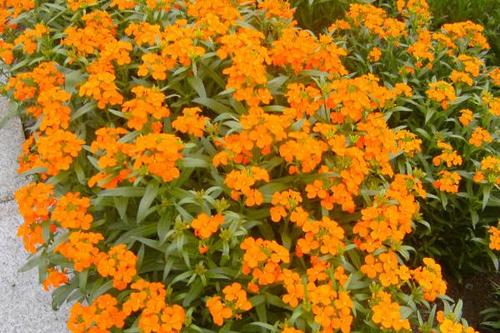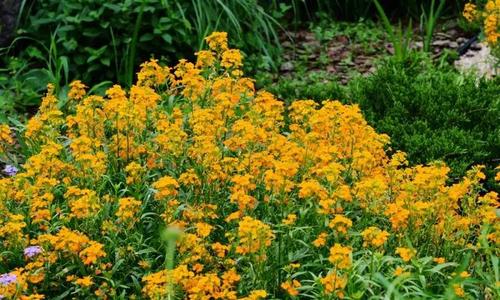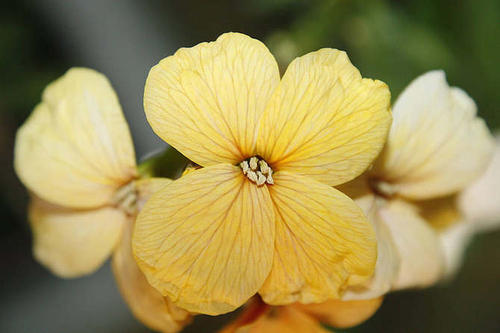Cheiranthus cheiri (wallflower) profile
Written by Maggie
Feb 26 2021

Wallflower, scientific name Cheiranthus cheiri, the color is orange and yellow brown, strong aroma. There are double varieties, like sunshine, cold resistance, but afraid of heat, a common garden flower in spring, and can also be used as cut flowers.
Wallflower picture

Morphological characteristics of wallflower
Stems
Wallflower is a perennial herb, 20 -- 60cm tall. Stem is erect or ascending, angular, proximally lignified, branched, whole plant adnate and pubescent.
Leaf
The basal leaves of wallflower are rosette; Petiole is 7-10mm long; Leaf blade is oblanceolate, lanceolate to linear, 1.5 -- 7cm long, 5 -- 15mm wide, apex acute, base tapered, entire or slightly denticulate; Cauline leaves are smaller, subsessile.
Flowers
The wallflowers were racemes elongated at the fruit stage. Wallflower, has 4 sepals, oblong, 6 -- 11mm long; Wallflower, has 4 petals, orange or yellowish brown, obovate, ca. 1, 5cm long, clawed; Wallflower, has 6 stamens, subequal; Pistil 1, ovary few with very short stipe, stipe linear, style short, stigma dipole diverged, deeply lobed.
Fruit
Fruit of Wallflower is long hornlike of wallflower linear, 4 -- 7, 5cm long, oblate, 4-ribbed, erect, stiffly straight, petals conspicuously medial. Seeds 2-row, ovate, light brown, apex winged.
The ecological habits of wallflower
Wallflower likes sunny, cool climate, slightly cold, fear of waterlogging and avoid heat. In the south of the Yangtze River Basin, the winter can be overwintered on open land, and in the eastern part of China, the winter can be overwintered under the leeward and sunshine beds with a little heat preservation measures. Wallflower, is suitable for loose, fertile and well-drained soil, and can tolerate mild saline-alkali soil.Fear of waterlogging avoids heat, excessive rain growth poor.
Growing methods of wallflower
Selection of cultivation site
It is advisable to choose a plot with sufficient sunlight, loose soil and good drainage without any other cruciferous plants planted. Shading should be needed in mid-summer. Since there are few roots of Wallflower, it is necessary to bring the permanent soil when transplanting. Planting should not be too dense, so as not to affect ventilation and light. The soil requirements are not strict, can withstand light alkali, poor growth in acid soil.
Seed collection and insulation
In cold areas, winter can not be exposed to the ground, need to build a shed to cover the plastic film, or before winter seedlings, store into the cold room for winter, until the spring is warm, before the new roots are moved to the open ground, but to bring the original soil, otherwise easy to hurt the roots and affect the survival rate. When the longhorn horn fruit color becomes yellow, seeds of Wallflower can be collected in batches, dry, thresh, collection. Seeds of Wallflower can be stored for 5 to 6 years.
Fertilizing and watering
When the weather gets warm and the wallflower grows more lumps, dilute liquid fertilizer should be applied every 15~20 days, and attention should be paid to watering. Flowering period to control moisture, do not need fertilization. Rainy season to prevent waterlogging, timely drainage after rain.
Pick the heart clip
In order to increase the amount of Wallflower, we should pay attention to the core picking and increase the germination of lateral branches .In order to make the wallflower bloom again after flowering, it is necessary to cut off the remaining branches in time, apply quick fertilizer and pay attention to watering and cool down in summer, so that the wallflower can bloom again in autumn.
Cultural essentials
North is biennial cultivation. Sowing period in autumn, sowing first into the open seedbed, because the seedlings are not resistant to transplanting, it should be in the winter before the seedlings, stockpile into the cold bed with cold resistant equipment for winter. The earlier the spring planting, the better, in order to prevent the seedlings after the temperature rise in the cold bed to give out new roots, then transplanting easily damaged roots, affect the survival. Cut off the inflorescence branches of Wallflower after the flower drops, and dig out the perennial roots for storage after recutting in autumn. Plant the perennial roots separately in the early spring of the next year to save the trouble of sowing seeds every year. The cultivation and management of Wallflower is extensive. Generally, the soil should be kept moist after colonization, and thin liquid fertilizer should be applied once about 3 weeks. Early spring after flowering is cut to residual flower branches, timely topdressing 1 ~ 2 times quick effect liquid fertilizer, frequently watering, makes Wallflower grow as soon as possible, so 9 ~ 10 months can bloom again. Wallflowers can also be planted in spring and summer, winter before the basin moves into the indoor culture, the early winter can blossom.
Recovery processing
Seeds of Wallflower are alive, and the strength of their vitality and the length of their life are closely related to the storage conditions. Under the conditions of warm, moist and unblocked air, the seed life activity is intense, the nutrients in the seed are consumed rapidly, the seed life becomes shorter, and the seed which has lost the vigor of life can not be used for sowing and seedling. Seeds in low temperature, dry, slow air circulation conditions of seed life activity is slow, seed life can be relatively prolonged.
Do a good job of cleaning seeds
Seeds of Wallflower should be cleaned after harvesting. The whole plant should be dried and threshed, and the peel, flesh and various appendages should be removed if the fruit is harvested together. The Wallflower seed grain is small, the weight is light, some kind of belt has downy hair short spines, easy adhesion or mix with sclerotinia, gall, worm egg and weed seed and other living impurities and residual leaves, silt and other in living impurities.
Reasonable drying
Wallflower seeds need to be dried after harvesting, must be basked in together with the fruit shell, do not put the seeds in cement sunken ground or placed in metal containers in the sun, otherwise the shadow will affect the vitality of the seeds. Seeds of Wallflower can be placed on canvas, reed mat, bamboo mat drying. Some seeds are afraid of light, can use natural wind dry method, be about to be placed in ventilated, rainproof indoor, make it natural dry. The safe moisture content of common herbaceous flower seed is 7% below.

Seed storage technology in Wallflower
The correct packing
The general number of flower seeds is less, the life is short and the price is expensive, under most circumstances, the use of polyethylene aluminum foil composite film bag, coat paper seed bag. The flower seed appropriate that contains aromatic oil is installed in a metal canister, wooden box or colored vitreous bottle store. Canning and aluminum foil bags can also be pumped into vacuum or semi-vacuum states when sealed to reduce the amount of oxygen in the container. The name of the seed and the year, month, day and service life of the seed should be correctly marked on the outside of the seed bag.
Low and tidal storage
Seeds of Wallflower that have been washed and dried to a safe moisture content and packaged in aluminum foil bags or metal cans should be kept dry, sealed and at low temperatures (2-5 ° C). Seed bags or cans should be placed on a shelf or platform about 50cm from the ground. Do not contact the seed bags directly with the ground to prevent dampness. A small amount of seeds of Wallflower can be stored in the dryer, the dryer can use glass bottles, small mouth with a lid jar jar, plastic bucket, etc., the bottom of the lime, silica gel, dry vegetation ash, charcoal, etc., as a desiccant, put seed bags, and then be airtight, placed in low temperature dry place.
Seed preservation
1-2 - year - old herbaceous Wallflower seeds should be stored in low temperature, dry, airtight conditions. The storage period of 1 year has fu lu test, ground skin, primrose; The storage period of 2-3 years are drunk butterfly flower, flower rhombus grass, pansy, marigold, girl cherry, kingfishy, Daisy, nasturtium, fragrant bowl bean, poppy, drunk butterfly flower, a string of red, wheat straw chrysanthemum, snapdragons, cornflower; The storage life of 4-5 years are half lotus, zinnia, wallflower, ophiolia, violet, petunia, amaranth tricolor, cockerhead, calendula and so on.
Wallflower propagation methods
Sowing and cutting methods are used for wallflower propagation, and usually seeding is the main method.
Sowing propagation
Wallflower is better to sow in autumn, which is generally carried out in autumn and spread in the open field. Before sowing, the ground will apply sufficient base fertilizer, rake evenly, leveling, for the bed. The width of the bed is lm, and the length is determined by the number of sowing, but it can not be too long, otherwise it is not easy to level the bed. The whole ground will be filled with enough water, when the water is completely into the soil, the seeds will be evenly spread on the bed, covered with a thin layer of soil, and then covered with grass on top, to reduce the evaporation of soil water. If the soil is found to be dry, water Wallflower in time. To avoid breaking out the seeds, water can be poured over the grass. Keep the temperature at about 20℃, it will take about a week for the seedlings to emerge, and then after the low temperature in winter, the next spring flowers will bloom. North is biennial cultivation. Sowing period in autumn, sowing first into the open seedbed, because the seedlings are not resistant to transplanting, it should be in the winter before the seedlings, stockpile into the cold bed with cold resistant equipment for winter. The earlier the spring planting, the better, in order to prevent the seedlings after the temperature rise in the cold bed to give out new roots, then transplanting easily damaged roots, affect the survival.
Cutting propagation
Cuttage is used for the reproduction of double varieties, cutting time in early summer or autumn, take the growth of robust, the year of hard shoots, cuttings length of 5~6 cm, inserted in the sand bed, deep 2 ~ 3cm, pay attention to the appropriate shade and moisture, temperature maintained at about 25℃, easy to root, high survival rate.
Disease control of wallflower
Wallflowers in high humidity, high temperature, poor ventilation, prone to diseases and insect pests, such as black spot, aphids, red spiders, etc., to Wallflower timely control.
Reference agents: 40% dioxate, 50% carbendazim, etc.
Species taxonomy of wallflower
There are about 10 species in the same genus of Wallflower, among which C. allionii, 2-year old or perennial herbaceous flower, plant height 30-40 cm, is the most common cultivated species .Leaves alternate, lanceolate. Terminal racemes, bright yellow flowers.Flowering in May.
The distribution area of the wallflower
Wallflower is originally from southern Europe and is widely cultivated throughout China. Now North China, Northeast China, East China, South China, Northwest China, Central China, Southwest China for large areas of planting.
Wallflower main value
The wallflower is a rare flower with golden color. Wallflowers can be arranged in flower beds, flower borders, but also for potted flowers.
The fragrance of cassia twigs is often used in the environment decoration of festivals such as Women's Day, Labor Day and Mother's Day, as well as the environment beautification of the living space during the period of spring.
The wallflower flower language
Be honest and honest in times of trouble.

Latest Updated
- Benefits of Bugleweed - 7 Science-backed Health Benefits
- Bugleweed Dangers & Side Effects - Is It Poisonous?
- How to Plant Evergreen Trees - What You Should Know
- When to Plant Evergreens - Grow Guide for Evergreen Trees
- 12 Wonderful Evergreen Shrubs for Your Garden
- 12 Popular Evergreen Plants with Pictures for Beginners
- When And How To Prune A Lilac Bush Like a Pro
- How to Grow & Care for Lilac Vine (Hardenbergia Violacea)
- Japanese Lilac Tree (Syringa Reticulata) Care & Propagation Guide
- Shumard Oak Pros and Cons - What to Know
Popular Articles
- Winter maintenance of Antirrhinum Majus
- How to Grow Terminalia Mantaly Tree
- How to Grow and Care for Crossostephium Chinense
- How to grow Antirrhinum Majus in spring
- Peristeria Elata (Dove Orchid) Profile: Info & Care Guide
- Underwatered Snake Plant (Sansevieria Trifasciata) - Signs And How To Fix
- How to Care for Brazilian Jasmine Plant (Mandevilla Sanderi)
- How to Grow & Care for Graptopetalum Purple Delight in Summer
- Rosa Chinensis (China Rose): Plant Growing & Care Tips
- How to Care for Baby Sun Rose (Aptenia Cordifolia)